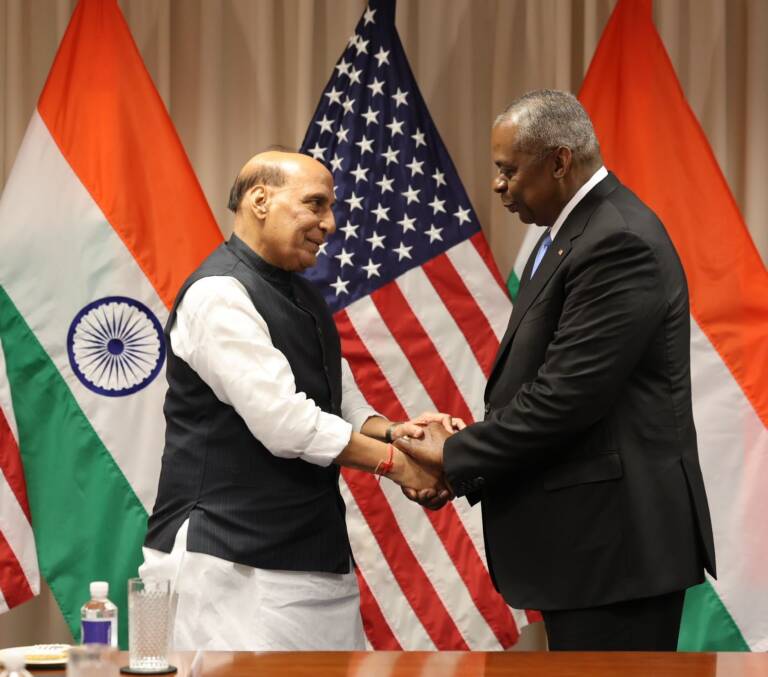India and the USA enter into two strategic agreements in the defense sector

India and the US have taken a notable step forward in defense collaboration which paves the way for strategic and mutual supply.
This is the conclusion of two very important agreements for the development and mutual assistance in the field of defense supplies, the SOSA and the RDP: under the SOSA, the United States and India will provide mutual support priority for goods and services that promote national defense. The United States Department of Defense (DoD) .
RDP agreements are intended to promote the rationalization, standardization, interchangeability, and interoperability of conventional defense equipment with U.S. allies and other friendly governments. So far, the United States has signed RDP agreements with 28 countries.
Invariably, the SOSAs that the United States has concluded with other countries have followed the conclusion of RDP Agreements with them, and not otherwise. Along with Singapore and South Korea, India appears to be an exception in this regard.
The above question assumes importance in the wake of the just concluded visit of Indian Defense Minister Rajnath Singh to the United States. The visit was marked by what is said to be an important conclusion of a bilateral but “non-binding” SOSA, under which the United States and India agreed to provide priority support to each other for goods and services that promote national defense.
The agreement will allow both countries to acquire the industrial resources they need from each other to resolve unexpected supply chain disruptions to meet national security needs.
Officials from both countries say the conclusion of SOSA represents a pivotal moment in the relationship between the United States and India as a Major Defense Partner and will be a key factor in strengthening the Defense Technology and Trade Initiative (DTTI) between United States and India and to deepen cooperation between their respective defense industrial bases.
The Importance of SOSA Agreements
In fact, SOSAs are bilateral agreements that allow each participant to request priority delivery for acquisitions from the partner country's industry, including direct purchases of final products and acquisitions of critical parts from lower levels of the supply chain.
SOSAs are also said to “encourage partner nations to acquire defense assets from each other” and “promote interoperability” between the United States and its allies and partners.
Furthermore, if all goes well as per the agreed terms, SOSAs “can add resilience to supply chains, helping to identify alternative sources when a key supplier has reached its production capacity”, it says.
With the addition of India, the United States now has 18 SOSA partners: Australia, Canada, Denmark, Estonia, Finland, India, Israel, Italy, Japan, Latvia, Lithuania, Netherlands, Norway, Republic of Korea, Singapore , Spain, Sweden and the United Kingdom.
Three key points emerge from the list
First, apart from India, the other 17 are close military allies of the United States, either through NATO or formal bilateral security ties. One might argue that Singapore is not exactly a treaty ally of the United States, but in reality it is much more, given the range and depth of its security ties in the Indo-Pacific region.
Second, the list has expanded, but slowly, over the years. Denmark, Japan, Israel and South Korea only became America's SOSA partners in 2023, and now India has joined the list.
Reports suggest that Korean industries are still discussing whether this agreement will promote cooperation between industries, in addition to the existing relationship between governments. It is no surprise that SOSA is non-binding in nature.
SOSA alone does not guarantee that foreign companies will be able to sell their products to American counterparts. The opposite is also true. This is guaranteed by the Reciprocal Defense Procurement (RDP) Agreements that the United States has with 28 countries.
In the absence of an RDP agreement, no country is automatically qualified for exemption from the Buy American Act. For this, a US regime must make special and unique decisions. Otherwise, this law makes it mandatory that goods purchased with federal funds contain 75% domestic content.
The RDP Agreement also allows you to make evaluation offers of qualified national products without applying the price differentials otherwise required by the Buy American Charter and the Balance of Payments Program.
Therefore, with the signing of these two agreements, India integrates into the US supply standards, opening new avenues for its shipbuilding and military industries. At the same time, the USA secures the collaboration of a large industrial country, with considerable potential and the ability to produce at prices that are fractional compared to those applied by American industry. Without forgetting the opportunity to also become suppliers to India for the most advanced technologies.

Thanks to our Telegram channel you can stay updated on the publication of new Economic Scenarios articles.
The article India and the USA make two strategic agreements in the defense sector comes from Economic Scenarios .
This is a machine translation of a post published on Scenari Economici at the URL https://scenarieconomici.it/india-e-usa-stringono-due-accordi-strategici-nel-settore-della-difesa/ on Tue, 27 Aug 2024 12:13:10 +0000.
